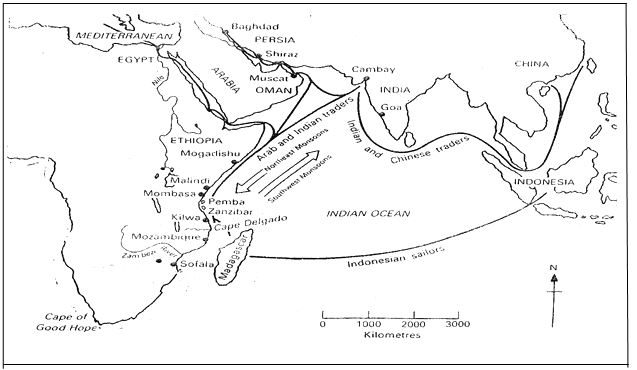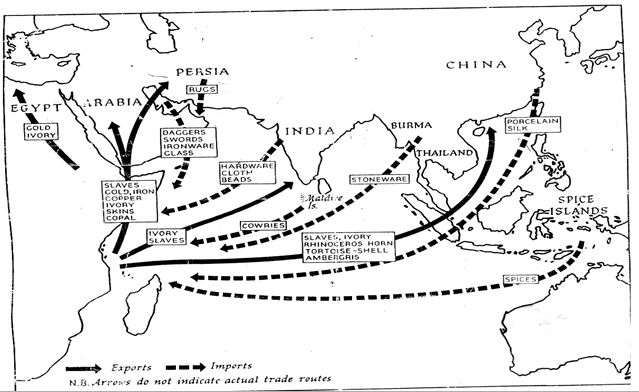Early Contacts with the Middle East and Far East
Contacts with the Middle East and Far East began as early as 200BC. Early foreigners to visit the African coast were people from Asia including countries like Syria, Arabia, India, Burma, Thailand, China, Spice Islands and Egypt from North Africa. Availability of goods such as ivory, gold, animal skins and slaves was one of the motives which attracted the traders to visit the East African Coast.
Historically, contacts between East Africa and Middle and Far East go as far back as 200 BC. Evidence is shown through archeological excavations. These have revealed remains of pottery, porcelain, cons, beads and tombs along the East Africa Coast which are believed to originate from Middle and Far East. Another piece of evidence from the book “Periplus of the Ertythrean Sea” or a Guide Book to the Indian Ocean, written in the 1st CAD by early Greek Trades, contain details about life at the East African Coast.
Regular trading contacts began around 8th CAD. Most of the traders came from China, Indonesia, (East Indies) and India. Later in the 10th C, traders also came from Arabia, Persia (Iran), Syria and Egypt. Their commercial activities covered the whole of the Eastern Coast of Africa between Mogadishu and Sofala.

The Social and Economic Motives of Contact between Africa, Middle East and Far East
Explain the social and economic motives of the contacts between Africa, middle east and far east
Motive of the contact
- Availability of goods such as ivory, gold, animal skins and slaves which had attracted the traders.
- The discovery of the power of wind and its patterns i.e. the Monsoon which helped to drive their vessels across the Indian Ocean to East Africa (South West Monsoon, November, to April) and back to their home lands (North East Monsoon, May to October).
- Development of marine vessels technology.They could contract large dhows which enabled them to carry huge quality of goods.
- Acceptance by the local people along the coast.They expected to benefit in the trading relationship.
- Constant warfare in the Middle East especially Persia made Arabs flee to East Africa their survival depended on trade.
The Major Commodities which were Exchanged during the Contact between Africa, Middle East and Far East
Identify the major commodities which were exchanged during the contacts between Africa, middle east and far east
Commodities (export) from Eastern Africa

GOLD form Mwanamutapa Empire was brought to the coast at Sofala. The gold traders (foreigners) had to pay tax to the rulers of Kilwa.
- Ivory - Was brought to the coast at may points
- Slaves - Were brought to the coast at many points
- opper - Was brought to the coast from Katanga
- Cum Copal - Was found on the coastal area opposite
- Other Goods - Rhinoceros horns, tortoise shells, beeswax
Imports to East Africa
- From India-Cotton clothes, beads and iron implements
- From Maldives Islands-Cowries shells which were used as money and also as ornaments
- From China -Silk clothes, porcelain
- From Arab and Persia -Swords, daggers (weapons), glassware and Persian rugs.
- From East Indies (Malaysia or Spice Islands) - Spices
- From Burma and Thailand - Stone ware i.e. pots and jars
Means of transport
The foreigners travelled in dhows which were driven with the help of Monsoon winds. The North East Monsoons (Winter Monsoons) blew between the months of November and April and brought the traders to Eastern Africa, South East Monsoons (Sumer Monsoons) which blew between the month of May and October took them back to their homes.
The Social and Economic Effects of the Contacts between the People of Africa, The Middle and Far East
Explain the social and economic effects of the contacts between the people of Africa the middle and far east
The rise of Coastal City states
By the 13th C, trade along the Coast of East Africa was strengthened and gave rise to city states. Many Arabs settled in the area for commercial purposes. The settlements grew into towns/cities: Kilwa, Mombasa, Zanzibar, Pemba, Malindi, Mogadishu, Lamu, Sofala, Pate and Kismayu.
Intermarriage
The Arabs, mainly intermarried with Africans within their Coastal settlements.The outcome of this racial mingling was the emergence of the Swahili people
The Growth/Emergence of the Kiswahili Language
This resulted from the mixture of Bantu and Arabic words
Introduction of New Arts and Crafts
Buildings along the Coast eg. Houses, palaces, mosques were built in Arabic and Persian styles (using stones)
Introduction of Islam
The Arab traders brought their religion with them.Therefore several coastal Africans were converted to the Islam faith.The Africans copied Arabic styles of dressing – men dressed in kanzu and women in baibui.
The Coastal Towns (Cosatal City States) 1000 AD-1500 AD
The coming of the Asian traders to East Africa especially Arabs led to the development of Coastal towns such as Mogadishu, Merka, Brava, Kismayu, Lamu, Pate, Malindi, Mombasa, Zanzibar, Pemba, Mafia, Kilwa and Sofala.
Political control
There was never a single united empire on the coast, no ‘Zenji Empire’ as sometimes believed.Each town retained its own rulers though many were dominated at different times by the most powerful settlements. Many had ruling families descending from Persia or Arabian rulers.
The Leading Coastal Towns
Mogadishu
- It was the first to gain wealth and importance due to its position in the North, This enabled it to control the sea route to the South and to dominate the trade from the rest of East Africa.
- It is said to have been founded in the 11th Century by a group of people from Persian Gulf.
- It became an important Islamic centre.
- It gradually declined as towns such as Kilwa and Mombasa gained importance.
Kilwa
- For many centuries it became important because it controlled most of the trade along the coast.
- Its greatness reached the highest peak in the 13th Century when it gained control over gold trade from Sofala. it built huge beautiful stone buildings eg. The Husuni Kubwa Palace and Friday Mosque.
- It also became an important Islamic Centre. Kilwa was the first coastal state to mint its own coins. It declined at about 1490 A.D.
Zanzibar
- It is believed to be the first coastal stop in East African coast to be settled by foreigners.
- It was free from Kilwa and had Arab rulers who were able to establish strong control over the people.
- Having powerful rulers, it became an important trading centre and in the 15th Century it began to mint its own coins.
Mombasa
- Mombasa was an export centre for Ivory and slaves before 15th Century.
- Its importance and wealth was a result of its trade with India
- The rulers were Swahili and the African element in its culture was strong.
Malindi
- It was an important market centre for exporting iron which came from mainland Kenya.
- It accepted Islam religion and the rule of Sultans. The people copied new ways of Government administration from Arabs.
THE DECLINE OF THE COASTAL CITY STATES
Trade between East Africa, Middle and Far East was disturbed by Portuguese invasion along the coast in the 16th Century and 17th Century. The Portuguese attempted of capture and control the Indian Ocean trade and this led to wars.The Portuguese invasion on the East African coast caused four major changes in the pattern of trade:
- There was diversion of the major trade routes especially in connection to with copper and gold. These items were now shipped overseas from Sofala southwards and through the Atlantic Ocean.
- Conflict developed between African gold miners and Portuguese traders. The Portuguese sought control of gold production and this was resisted by African miners and there was a decline in the output of gold.
- Portuguese imposed trading licenses and permits on African and Arab traders. This led to further decline of trade between East Africa and Asia.
- Coastal City states such as Kilwa began to decline because their prosperity depended on gold trade. This meant the African and Arab traders who acted as middlemen also lost business.


mostly wonderful am very interested on the lesson
ReplyDeletePost a Comment